In this blog post I want to share a powerful tool, the Leadership Health Check. It will help you become stronger as a management team and reveal improvement opportunities for how you, as a team of active servant leaders, better can enable the agile teams you support.

But first, let’s take it from the beginning.
One of my favourite exercises in my toolbox as an agile coach is something I learned during my years at Spotify; the Squad Health Check. It’s a retrospectives format, a self-evaluation workshop, in which the teams express how they feel they’re doing on wide variety of topics such as collaboration, value of what is delivered, ability to influence, received organizational support, etc. The result generates insights and commitment to actions of improvement for both the team and the supporting leadership. I love it because I believe it’s a great tool for strengthening autonomy, culture and continuous learning.
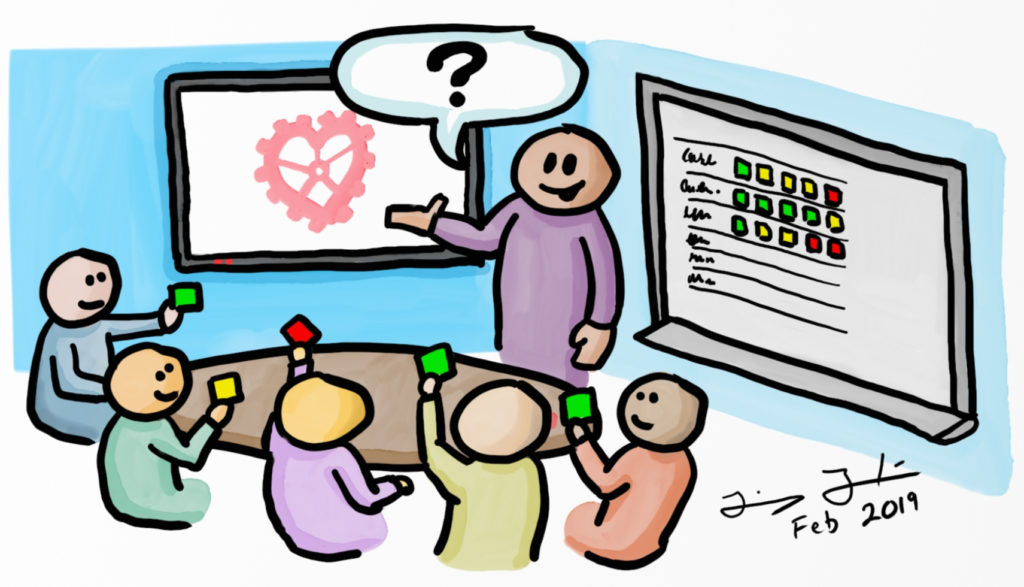
More than a year ago, a colleague at Spotify Georgiana Laura Levinta and I created a health check for the leadership of our Tribe (Tribe is a semi-autonomous department at Spotify encapsulating 4-8 teams and with a dedicated set of leaders and managers). Geo and I were inspired by the Squad Health Check, but the goal with this adoptation was to help the Tribe’s managers perform a self-evaluation of their ability to provide active supportive leadership to the squads within the tribe, and to generate a discussion on how they can improve as a team to be able to provide even better support.
Since then, I have together with my current client Casumo, adopted this for their context, culture and beliefs. We’ve run it several times with great success and value, both with the company’s leadership team but also on cluster level (semi-autonomous department). I believe the Team Health Check and the Leadership Health Check both are tremendously powerful; hence I want to unleash them to the wider agile community, hoping that more organizations will find them valuable and useful. Or at least be inspired by them, and then try something totally different.
If you don’t want to read about the origin and thinking behind the team and leadership health checks, and only came here to download the workshop material, scroll down to the very end of this blog.
.
Team Health Check
.
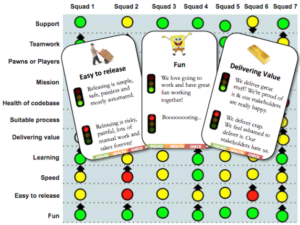
The origin
The first version of the Squad Health Check at Spotify looked very different from today’s versions. It posed questions like “Do you have a present Product Owner?”, “Do you have the support of an Agile Coach?” and “Is it easy to release?”. As these organizational pain points (for example not all teams having a product owner) gradually diminished, the survey evolved to focus more around autonomy, team work, sustainable process and mission clarity (see example to the right).
The format quickly went viral internally at Spotify, with more and more teams and tribes using it. Today it is an ingrained habit in many parts of the organization. Teams do it two to four times a year. As each tribe adopt it for their context and needs and shares their versions with each, the tool keeps evolving.
.
The Team Health Check
The Team Health Check I share in this blog post is inspired by Spotify’s Squad Health Check. Through my work with other clients I have evolved it and made it more generic. The current phrasing of topics and statements tries to embed ideas and research presented in books such as Teamwork is an Individual Skill by Christopher Avery, Leading Teams by J. Richard Hackman) Drive by Daniel H. Pink, Team of Teams by Stanley McChrystal, Google’s Aristotle Project, The Five Dysfunctions of a Team by Patrick Lencioni, and many more books and agile thought leaders.
The health check itself consists of roughly 12 topics. For each topic, there is a green and red statement. The green statement describes observable healthy or positive examples. The red, unhealthy or bad examples. Here follow two examples;
Team Autonomy
Green: I feel we influence and shape our plans and destiny. We decide together how we want to work.
Red: Someone else is always calling the shots. It’s unclear to me what we are allowed to decide, and what we’re not.
Feedback
Green: We give positive appraisals, but also provide constructive feedback on each other’s unproductive behaviours.
Red: We rarely praise each other, or give feedback to each other for acting irresponsibly or breaking our Working Agreement.
.
Adopting the Team Health Check
If you want to run the Team Health Check with teams in your organization, I strongly encourage you to revise and adopt it for your culture and your context and to make conscious decisions of what to keep from the templates you can download below. I believe this is a great leadership exercise. The challenge of defining the topics and statements forces you as leaders to agree on what culture you aspire to build, which behaviours you want to see and what members of a team should be able to expect from the leadership and the org.
Since teams might conduct health checks several times a year it will, in a way, serve as an education of what you strive towards and in some sense become a bill of rights for the teams. If they every time get the question if they feel they’re able to influence and shape their plans and destiny, they are taught that that’s the way it should be. If asked if they have time to think ahead and experiment, it implies that they should be allowed to carve out enough slack to do so. And so on.
.
The value it provides
In my experience, running a Team Health Check with the teams two to four times per year will…
- Increased awareness of where the team is at, it’s state, challenges and opportunities
- Trigger qualitative discussions within each team with regards to their current state of health.
- Generate improvement actions within the team, as any good retrospective.
- Reveal to the leadership in which ways they need to improve as servant leaders or in which way the can provide additional support to enable the teams
- Communicates expectations of desired behaviours (such as collaboration, feedback, integrity) as well as what teams should be allowed to expect from the leadership of the organization (support, trust, involvement, connection to purpose and why).
.
It’s not a tool for comparison!
If you as a team fear, or notice, that the results from the self-evaluation is used by management to compare how “good” different teams are – don’t share your results outside the team! Use it like any other retrospective format, as a tool for generating insights, discussions and actions. Share actions, the output, but not the discussions themselves.
If you as a manager is tempted to use the tool to evaluate a team’s “agile maturity”, effectiveness or for comparison between teams – DON’T! The answers will be very subjective, reflecting each team’s very specific context and challenges. If anything, the results from the exercise reveals how good you are at providing support to your teams. It’s not a measure of how they are doing, it’s a measure of how you as a leader is doing.
.
Leadership Health Check
The purpose of the Leadership Health Check is the same as for the Team Health Check, to self-survey how well we feel we are doing as a team on a wide variety of areas, and reveal how we can improve collaboration and the value we deliver. The team in this case is the group of managers and leaders for a set agile teams. The value we deliver is the support we provide our teams, and the things we do to help the teams deliver value to their users and stakeholders.
.
The origin of the Leadership Health Check
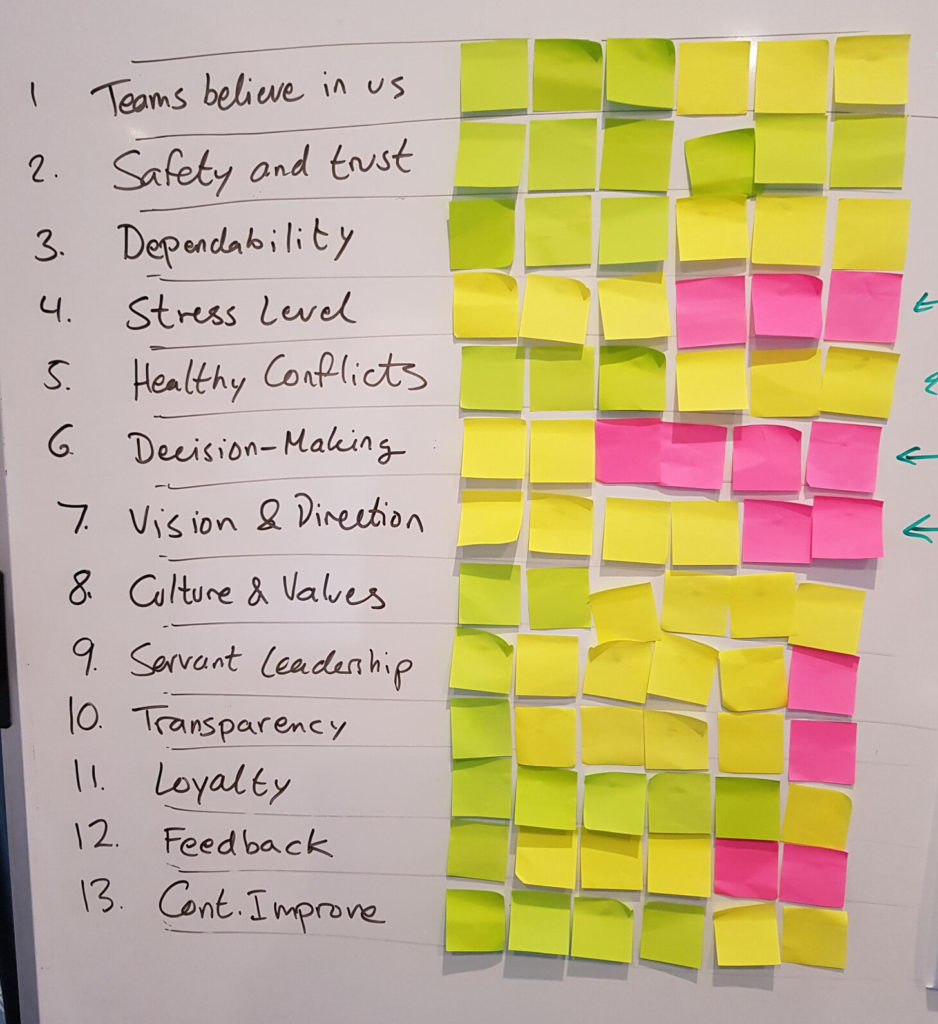
As I mentioned in the beginning of this article, the first version of the Leadership Health Check was co-developed with Georgiana Laura Levinta a colleague at Spotify. Georgiana also wrote a Spotify internal blog post about the creation of the tool. Hopefully it will someday be published on Spotify’s official blog.
The version I’m sharing here is the one I’ve been running with my current client, Casumo. It has triggered great discussions about leadership in agile environments. It has gelled teams of leaders and inspired actions and changes to further improve the way they support their teams.
It has proven to work well both for the company’s leadership team (consisting of the CEO, CTO, CFO, etc), and for department level leadership. The workshop has generated insights and guided the leadership team on where focus their efforts next.
.
It’s designed for the management/leadership team
The Leadership Health Check acknowledges that a team of leaders/managers differs from a team working closely together to ship a product or that offers a service. They might not collaborate towards short-term goals, instead what unites them is the service they offer – providing support, guidance, direction and an environment within which teams can flourish and excel. To do this effectively, they need to treat themselves as a team and align on values and long-term strategies, agree upon how decisions are made and what constitutes good leadership.
Some of the topics are the same as for the Team Health Check, such as Trust & Safety, Dependability, Continuous Improvement and Feedback. Others are specific for the Leadership Health Check, such as Culture & Values, Vision & Direction, Servant Leadership and Transparency.
.
Adopting the Leadership Health Check
My advice is the same as for the Team Health Check, if you want to run the Leadership Health Check in your department or company, I strongly advice that you adopt it to your culture and your believes on what great leadership looks like.
Agreeing on the set of topics and statements is a great exercise and will most likely trigger plenty of tough but healthy discussions that forces you to align and decide on what is important for you. For example, do you regard youself as a team or a loosely coupled group? Do you believe in inclusive decision-making or clear roles with clear mandate? Your stance on these questions should be reflected in your health check.
.
Community of Practice Health Check
And here comes a surprise bonus. When working with my current client I was approached by the Front-End Talent. A talent in their organization is a grouping of people with similar disciple or competence, sometimes called a Community of Practice. At Spotify this would be a Chapter. We developed a Health Check with topics tuned for the needs that members of a Community of Practice have on each other. They don’t typically worked towards a common goal the way a team does, but they do share other needs such as knowledge sharing, helping out, aligning on certain long-term strategies and so on.
The topics and statements are unpolished and haven’t gone through many iterations of improvements, if any. But, if you want to you can download it below. Maybe you can use it as a source of inspiration.
.
Facilitation
I facilitate the Team and Leadership Checks in more or less exactly the same way. I usually plan for a 90-minute session, and facilitate the workshop as follows:
1) Welcome – 5 min
Explanation of the purpose of the workshop and its structure. I emphasize that this is an exercise in self-evaluation, an alternative retrospective format, not a method to measure how good or bad we are as a team from any objective perspective.
2) Self-evaluation – 15 min
For each topic, I ask someone to read the topic and the green statement and red statement out loud. Then each person votes. If you think the green statement best exemplifies how things are, you vote green. If you think the red statement best exemplifies how things are, you vote red. If you’ve seen both green and red examples, or believe things are neither green nor red, you vote yellow. Votes are collected, and then I move on to the next topic and ask the next person to read it out loud, and so on.
Note: When doing this together in one room, I ask people to vote by pulling off a green, yellow or red Post-its. I then collect the Post-its and put them on the whiteboard. When facilitating the workshop with remote members, I prepare a Google Spreadsheet, and then ask the participants to vote in the document. In the screenshot below you can see both the voting of the team members as well as comments captured from the discussion that followed i step 4.
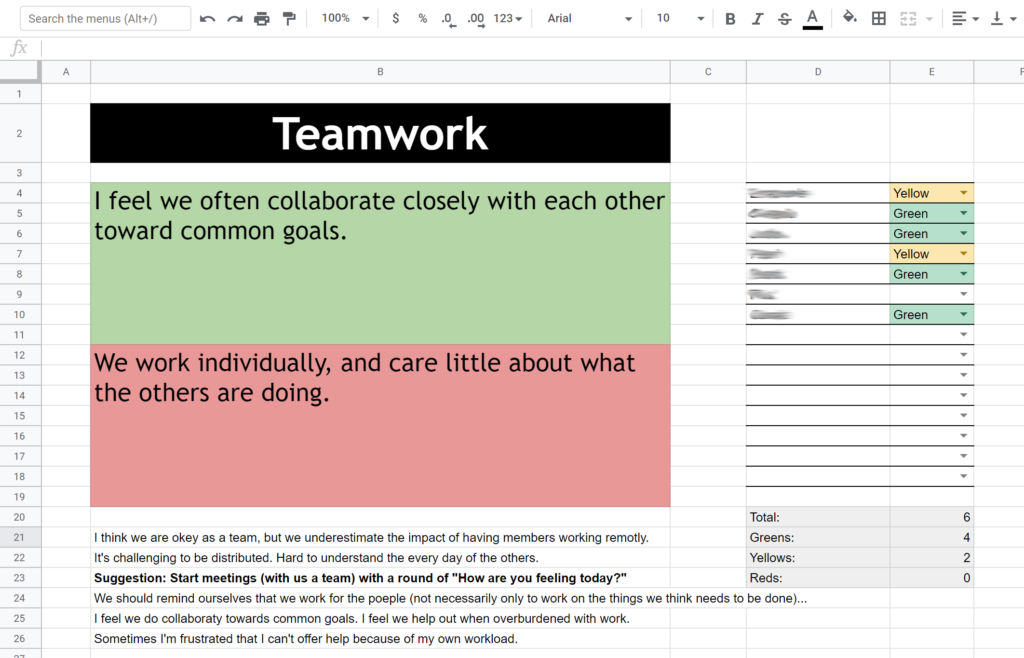
3) Reflection – 5 min
I ask everyone to briefly comment and reflect on the overall result. – 5 min
4) Search for improvement actions – 45 min
Go through and discuss the most interesting results. It could be the topics with majority of votes being red, or topics with the widest range of greens, yellows and red signalling that we perceive the topic very differently. I try to facilitate the discussion so that actions and improvements are suggested and decided upon.
5) Summary – 5 min
Repetition of agreed upon action points, and who will do what.
Ensure that someone is assigned to document and share the result.
6) Check-out – 5 min
A check-out round. I usually ask each person to briefly comment on “Which discussion or action do you believe was the most important one for us as a team?”
.
Common Questions
Q: For the answers to be thruthful, does this exercise require trust between team members
Yes. But I also believe doing exercises like this build trust. As team members learn that this is not a tool for evaluating them, but a tool for helping them become a stronger team themselves, the answers will be more honest. As a result, the discussions that follow generate deeper insights and more impactful actions and changes.
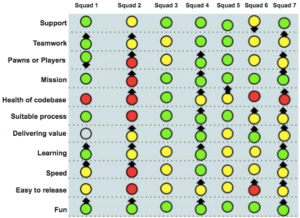 Q: Isn’t there value for a department in aggregating the results of several team’s Team Health Check?
Q: Isn’t there value for a department in aggregating the results of several team’s Team Health Check?
Of course. If you as leaders want to see patterns and trends in order to learn where you should focus your efforts, this can be very valuable. The image to the right shows a real example from Spotify. For example, this helped the leaders and teams prioritize work to make it easier to release. Squad 4 had been formed just two weeks earlier, so their self-awareness is probably really low since everything looks green. Squad 2 seems like they are struggling a lot. So these two squads were given extra support and care.
Q: But I really want to use it to compare how well different squads are performing. Why can’t I?
No you can’t! For several reasons. It’s a self-assessment so the results will reveal of the team percieves itself from their personal perspective. One squad might feel that they are moving at great speed and another very slowly, even though they both release on a weekly cadence. And the context and challenges for each team varies greatly. One team might ship daily updates to a website, another struggling with many external dependencies. One team might be large, another small. And so on.
If you use it for comparison, and maybe even for deciding which team to reward, the teams will figure this out and start to game the results with dishonest answers just to “look good”.
Q: Should the results be shared?
I am a strong believer in transparency, so if you ask me – yes. My advice though is to only share the results and agreed upon actions, not who voted what on each topic. Being transparent and sharing the results builds trusts, enables cross-team learning and fosters a sense of accountability.
Q: I feel some questions are too vague and too open for interpretation. What about dividing it up into more questions with narrower focus?
Sure, you can do that. If the questions don’t trigger good discussions and generate useful insights, please experiment with different questions. But my suggestion is to have no more than twelve to fourteen questions. If you add one, maybe you should remove another.
Q: Should I send out the questions and ask people to vote before the workshop in order to save time?
Maybe if it’s a big group, i.e. larger than 10-ish people. Otherwise I find it more engaging and fun to do it together in the workshop.
.
Download links
And finally, below you’ll find the download links. Don’t hesitate to copy and adopt them for your context and then run with your teams.
Enjoy!
.
|
Leadership Health Check
. |
|
Team Health Check
. |
|
Community of Practice Health Check
. |




Nice to see the squad health check model evolving into other areas 🙂
Thx for sharing back!
thnx for sharing!
Thanks for sharing Henrik
and thanks to Jimmy for sharing the next iteration 🙂
You are most welcome Jesper 🙂
This is outstanding!
Thank you all so much for sharing this amazing material for free with the community! I’m already seen dozens of different ways of applying this in the software Industry.
Happy to hear you got inspired 😀
I cannot agree more with you about not sharing the team health data outside the team, because it could led to comparisons, and comparing health/happiness of a team vs another has no sense.
It’s like comparing velocity.
Thanks for sharing Jimmy! Nice to see it all evolve. I’m actually working on a similar thing at the moment so will probably steal a few things from you 🙂
Thank you for sharing. This got me thinking about adapting something similar to the Leadership Health Check with my peer Scrum Masters that I work with….like a Scrum Master Team Health Check. 🙂 Thank you for the inspiration and getting my brain juices flowing this early morning.
You are most welcome Todd 🙂 Please share back what you discover when adopting it to a Scrum Master Team Health Check, if you want to.
Thanks for sharing Jimmy, it was resulted very useful for us.
We have used it to run a feedback 360º session among team members.
Each team member has been self-evaluated based on certain topics, and then each team member evaluated their pairs using the same topics.
It was an interesting exercise because it gives people both perspectives (how you see yourself and how others perceive you).
Thanks again.
Interesting! Thanks for sharing Federico 🙂 Happy to hear you found a way to use it that was useful to you.
Thanks for sharing it, Jimmy. I’m going to use it with my team.
We created a 360 feedback in our organization, but I feel this type of tool creates a collaborative improvement environment to the team.
Thanks.
I love this, thank you for sharing Jimmy 🙂
This helps me varying my approach to facilitating Leadership Teams that are looking for a mirror to look into.
A wonderful resource. Expected just a simple article with vague ideas, ended up with complete templates!
Would love to see this kind of health check be a standard in workplaces across any industry.
Hi everyone,
I’ve recently used this with 2 teams and they both asked to distinct trust and dependability within and outside the team: high trust inside, but outside not really… useful input for our team coach guild 🙂 working on it!
What’s your experience?
kr,
Thomas
One more thing.
Next time I will combine this health check with Clean Feedback and distinct observations (evidence) from interpretation & impact.
Will share how it went 🙂
great compilation. One of the best health check I have seen so far including SAFe. This is crisp and covers all dimensions and at all levels.
Fortunate that this is made available to the community for free.
Thanks a lot for all the great work.
This post is about translating the material to Swedish
Hej Jimmy, tack för ett utmärkt workshopmaterial! Vi har kört en första omgång och kommer att fortsätta. Vi kör en kombination där vi också har gemensamt erfarenhetsutbyte utifrån 12 dimensioner av agilt ledarskap utifrån den här modellen: https://www.linkedin.com/pulse/12-dimensions-agile-leadership-jonathan-kessel-fell (riktigt lyckad kombination). Nu till saken! Har du kriterierna på svenska? Annars tänkte jag ge mig på ett försök att översätta dem (vi kommer behålla 11 av dem initialt). Igen, tack för att du delar med dig!
Hej Anders!
Spännande att höra att ni provat health checkarna 🙂 Och att ni byggt vidare på dem och anpassat dem.
Jag har inte kriterierna på svenska, men varsågod att översätta dem själv. Lycka till!
Hej Jimmy, och andra Svenskar. Nu finns det en version översatt till svenska här:
https://drive.google.com/open?id=1A3uXxKZ8qwoLQraWoB93Droxqdn52sNqjYxKmG3fLt4
If you like, here is the presentation format of the questions. (the same as team and Leadership)
https://docs.google.com/presentation/d/1JwlGzwa2RbxdoHy1Ec7YbSunMoJzql02J0Ovb4aIKtk/edit?usp=sharing
Thanks so much for sharing Pascal!
Whow, how awesome that you are willing to share this. Valuable. Thank you for making a difference.
Hi,
This is very useful. I was looking for the right format for our leadership health-check. This works very nicely as we have already adopted the spotify squad health-check.
For the leadership health check could you provide a few more examples around the topics e. g servant leader, dependability etc.
Hi Jimmy – this is super – thank you so much. I am doing some work this week with managers and the structure you give is great. I was thinking about teams as organisms. That is, what makes a healthy organism like the human body. And a couple of things also came to mind.
1. Areas of Attention: without which the vision (surviving or thriving) is impossible and the team dies. For the body that’s three things Breathing, nourishment, shelter/temperature. for a software team it might be just one – happy/paying customers – and a happy team!
2. Goals: The body at any time has clear goals. Breathing trumps all else, except for split second moments where fight, flight, freeze may kick in but breathing trumps water trumps food etc. I know you have vision and a decision-making in your model – maybe that covers it but curious to know your thoughts!
Hi James,
Made me happy to hear you like the Health Checks. I think I like your angle, but as any metaphor, you can only take it so far. Aspects I lack is the need for collaboration and the relations between team members – as an organism you’re already connected together as a body.
Furthermore, I’m not sure the body has clear goals. I have needs. I have instincts. I react. (Breathing is not a conscious goal, it’s more of an automatic instinct/reacting right?) If I set my mind to it and work with focus – then I can achieve goals.
All this becomes philosophical. If it makes sense for you and help you propel change – go for it!
Hi. Thanks, Jimmy for this valuable resource.
I had a question: I am a Scrum Master for an Agile Product team (and facilitating this health check workshop for the team). Should I also submit my self-evaluation along with the team or should I abstain?
Note: I am asking the Product Owner to submit his self-evaluation along with the team.
Hi Yak! I think your perspective is important to, so I would recommend you participate in the exercise as well.
Best Regards
/Jimmy
Thanks Jimmy !
If anyone is looking for an online tool to enable the team to submit their self-evaluation (maybe you have a distributed team), I came across this tool https://squadhealthcheck.info/ that has the option to customize the cards and then have the team vote on the cards and trends.
Hi Jimmy, great resource, thanks for sharing.
What exercise do you use for step 4 ‘Search for improvement actions’?
Something like a 5 why on the most interesting results?
thanks
It varies depending on available time. Usually I try to exract ideas and improvement opportunities from the discussions. I then ask the group to add to that list and then finally vote or agree upon adressing a few of them.
Excellent
Great stuff, thanks for sharing!
The PPT deck has a copywrite notice without any public usage copywrite. Would it be possible to add a creative commons license or similar for those of us who want to use it?